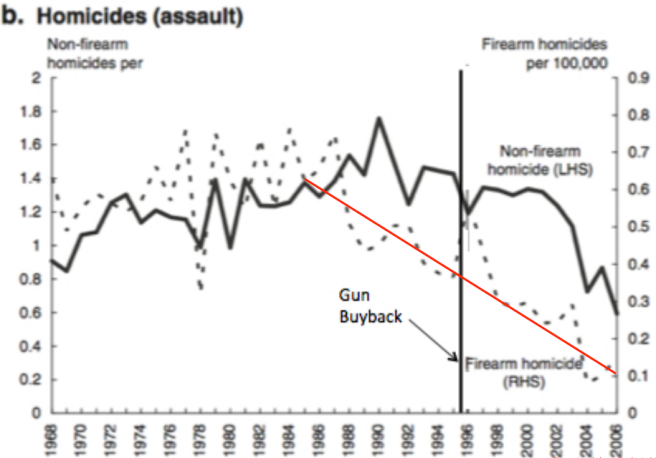My interest is engineering, physics and data analysis in the context of medicine. However, when you learn math and use it to build models you cannot help this filtering into everyday life, news and politics. In-fact it this reason why I urge nearly everyone I bump into to improve their math skills even if it means I’m the butt of a few jokes. Recently the mass shooting in Orlando has lead to a number of social media posts expressing their anger at Americans about how stupid America is for not banning guns. However, like most things in life the answer is never as simple. People have used the gun ban in Australia saying that before the ban there was x and after the ban there is y and that y is lower than x so why won’t the stupid Americans wake up. The reality is that economists in this area don’t just look at the difference in endpoints, they look at rates of change.
Gun homicides over time are charted in what you call a time series. Below is the rate of homicides before and after the gun ban in Australia. The dotted line is firearm homicides. As you can see I have drawn a line on the rate of change from 10 years before to 10 years after the ban.

As you can see you’d be hard pressed to claim that the gun ban had done anything to change the reduction in armed homicides. A classic trick is to present the data in the following way:
“And today, there is a wide consensus that our 1996 reforms not only reduced the gun-related homicide rate, but also the suicide rate. The Australian Institute of Criminology found that gun-related murders and suicides fell sharply after 1996.”
The water gets even muddier when you look at armed robberies. Before the gun ban, armed robberies were increasing at a lower rate than unarmed robberies.

In the five years after the ban before the peak and decline armed robberies drastically increased and now armed robberies are decreasing at a lower rate than robberies. We also have to realise that the USA has a larger population so even if the density of gun violence is lower than a smaller country it can still have numbers. Because of this, you need a ratio in order to find the density. When you do this you can see that there are a number of European countries that have a higher frequency of mass shootings and a higher number of deaths by mass shooting.


The message to take home is that it’s not simple or straightforward. The data doesn’t paint a clear picture. Being a politician is a thankless task. You cannot be angry at politicians who are hesitant to sign laws that have increased crime in other countries and not affect the rate of change in armed homicides. If a solution is really simple and politicians seem like idiots for not doing the obvious thing you’re either a genius or you’ve oversimplified it. The Dunning-kruger effect showed that the more people knew about a subject the less confident they were to provide solutions.

